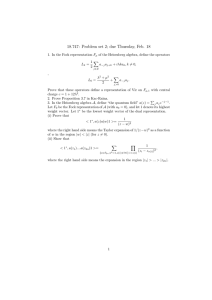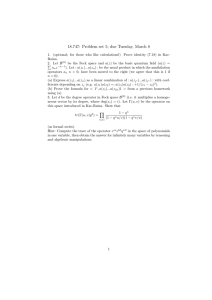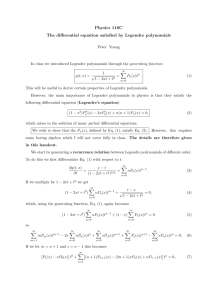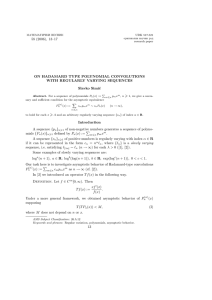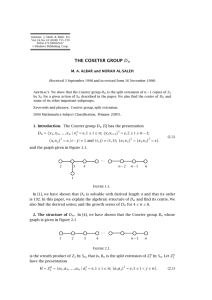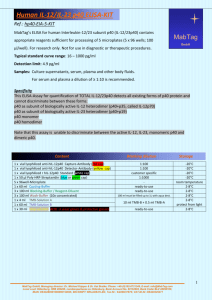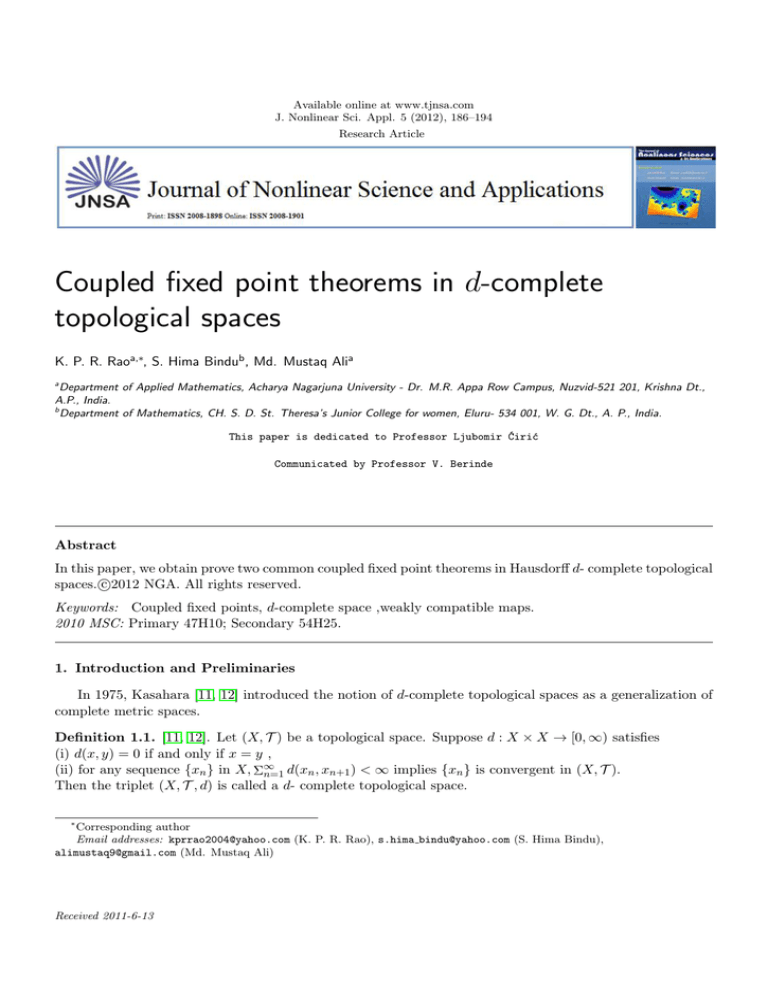
Available online at www.tjnsa.com
J. Nonlinear Sci. Appl. 5 (2012), 186–194
Research Article
Coupled fixed point theorems in d-complete
topological spaces
K. P. R. Raoa,∗, S. Hima Bindub , Md. Mustaq Alia
a
Department of Applied Mathematics, Acharya Nagarjuna University - Dr. M.R. Appa Row Campus, Nuzvid-521 201, Krishna Dt.,
A.P., India.
b
Department of Mathematics, CH. S. D. St. Theresa’s Junior College for women, Eluru- 534 001, W. G. Dt., A. P., India.
This paper is dedicated to Professor Ljubomir Ćirić
Communicated by Professor V. Berinde
Abstract
In this paper, we obtain prove two common coupled fixed point theorems in Hausdorff d- complete topological
c
spaces.2012
NGA. All rights reserved.
Keywords: Coupled fixed points, d-complete space ,weakly compatible maps.
2010 MSC: Primary 47H10; Secondary 54H25.
1. Introduction and Preliminaries
In 1975, Kasahara [11, 12] introduced the notion of d-complete topological spaces as a generalization of
complete metric spaces.
Definition 1.1. [11, 12]. Let (X, T ) be a topological space. Suppose d : X × X → [0, ∞) satisfies
(i) d(x, y) = 0 if and only if x = y ,
(ii) for any sequence {xn } in X, Σ∞
n=1 d(xn , xn+1 ) < ∞ implies {xn } is convergent in (X, T ).
Then the triplet (X, T , d) is called a d- complete topological space.
∗
Corresponding author
Email addresses: kprrao2004@yahoo.com (K. P. R. Rao), s.hima bindu@yahoo.com (S. Hima Bindu),
alimustaq9@gmail.com (Md. Mustaq Ali)
Received 2011-6-13
K.P.R. Rao, S. Hima Bindu and Md. Mustaq Ali, J. Nonlinear Sci. Appl. 5 (2012), 186–194
187
For details on d-complete topological spaces, we refer to Iseki [10] and Kasahara [11, 12, 13]. Hicks [6]
and Hicks and Rhoades [7, 8] proved several fixed point theorems in d - complete topological spaces. Hicks
and Saliga [9] and Saliga [19] obtained fixed point theorems for non - self maps in d - complete topological
spaces.
In 2006, Bhaskar and Lakshmikantham [3] introduced the notion of a coupled fixed point in partially
ordered metric spaces, also discussed some problems of the uniqueness of a coupled fixed point and applied
their results to the problems of the existence and uniqueness of a solution for the periodic boundary value
problems.
Later several authors proved coupled fixed and common coupled fixed point theorems in partial ordered
metric spaces , partially ordered cone metric spaces and cone metric spaces for two maps(Refer to [1, 4, 5,
14, 15, 16, 17, 18, 20, 21, 22, 23] ).
In this paper ,we prove a common coupled fixed point theorem for four mappings in d - complete
topological spaces.
Definition 1.2. ([3]).Let X be a nonempty set. An element (x, y) ∈ X × X is called a coupled fixed point
of the mapping F : X × X → X if x = F (x, y) and y = F (y, x).
Definition 1.3. ([1]).Let X be a nonempty set. An element (x, y) ∈ X × X is called
(i) a coupled coincidence point of F : X × X → X and g : X → X if gx = F (x, y) and gy = F (y, x).
(ii)a common coupled fixed point of F : X × X → X and g : X → X if x = gx = F (x, y) and y = gy =
F (y, x).
Definition 1.4. ([1]).Let X be a nonempty set. The mappings F : X × X → X and g : X → X are called
W-compatible if g(F (x, y)) = F (gx, gy) and g(F (y, x)) = F (gy, gx) whenever gx = F (x, y) and gy = F (y, x)
for some (x, y) ∈ X × X.
In this paper,we obtain two common coupled and common fixed point theorems for two and four mappings
satisfying a Berinde [2] type weak contraction conditions in Hausdorff d- complete topological spaces.
2. Main Results
Theorem 2.1. Let (X, τ, d) be a Hausdorff topological space.Let F, G : X × X → X and f, g : X → X be
mappings satisfying
d(f x, gu), d(f y, gv), d(F (x, y), f x), d(G(u, v), gu)
(2.1.1)
d(F (x, y), G(u, v)) ≤ h max
d(f x, gu), d(f y, gv), d(F (x, y), f x),
+L min
,
d(G(u, v), gu), d(F (x, y), gu), d(G(u, v), f x)
for all x, y, u, v ∈ X, where 0 ≤ h < 1 and L ≥ 0,
(2.1.2) F (X × X) ⊆ g(X), G(X × X) ⊆ f (X),
(2.1.3) one of f (X) and g(X) is d- complete,
(2.1.4) the pairs (F, f ) and (G, g) are W-compatible,
(2.1.5) d(x, y) = d(y, x) for all x, y ∈ X and
(2.1.6) for each y ∈ X, d(xn , y) → d(x, y), whenever {xn } ⊆ X, x ∈ X such that
xn → x.
Then F, G, f and g have a unique common coupled fixed point in X ×X and also they have a unique common
fixed point in X.
Proof. Let x0 and y0 be in X.
Since F (X × X) ⊆ g(X), we can choose x1 , y1 ∈ X such that gx1 = F (x0 , y0 ) and gy1 = F (y0 , x0 ). Since
G(X × X) ⊆ f (X), we can choose x2 , y2 ∈ X such that f x2 = G(x1 , y1 ) and f y2 = G(y1 , x1 ). Continuing
this process, we can construct the sequences {xn } , {yn } ,{zn } and {pn } in X such that
K.P.R. Rao, S. Hima Bindu and Md. Mustaq Ali, J. Nonlinear Sci. Appl. 5 (2012), 186–194
188
gx2n+1 = F (x2n , y2n ) = z2n , say ;
gy2n+1 = F (y2n , x2n ) = p2n , say ;
f x2n+2 = G(x2n+1 , y2n+1 ) = z2n+1 , say ; and
f y2n+2 = G(y2n+1 , x2n+1 ) = p2n+1 , say ; for n = 0, 1, 2, .... Now
d(z2n , z2n+1 ) = d(F (x2n , y2n ), G(x2n+1 , y2n+1 ))
≤ h max {d(z2n−1 , z2n ), d(p2n−1 , p2n ), d(z2n , z2n−1 ), d(z2n+1 , z2n )}
d(z2n−1 , z2n ), d(p2n−1 , p2n ), d(z2n , z2n−1 ),
+L min
d(z2n+1 , z2n ), d(z2n , z2n ), d(z2n+1 , z2n−1 )
= h max {d(z2n−1 , z2n ), d(p2n−1 , p2n )} .
Also
d(p2n , p2n+1 ) = d(F (y2n , x2n ), G(y2n+1 , x2n+1 ))
≤ h max {d(p2n−1 , p2n ), d(z2n−1 , z2n ), d(p2n , p2n−1 ), d(p2n+1 , p2n )}
d(p2n−1 , p2n ), d(z2n−1 , z2n ), d(p2n , p2n−1 ),
+L min
d(p2n+1 , p2n ), d(p2n , p2n ), d(p2n+1 , p2n−1 )
= h max {d(p2n−1 , p2n ), d(z2n−1 , z2n )} .
Thus max{d(z2n , z2n+1 ), d(p2n , p2n+1 )} ≤ h max{d(p2n−1 , p2n ), d(z2n−1 , z2n )}.
d(z2n−1 , z2n ) = d(G(x2n−1 , y2n−1 ), F (x2n , y2n ))
= d(F (x2n , y2n ), G(x2n−1 , y2n−1 ))
≤ h max {d(z2n−1 , z2n−2 ), d(p2n−1 , p2n−2 ), d(z2n , z2n−1 ), d(z2n−1 , z2n−2 )}
d(z2n−1 , z2n−2 ), d(p2n−1 , p2n−2 ), d(z2n , z2n−1 ),
+ L min
d(z2n−1 , z2n−2 ), d(z2n , z2n−2 ), d(z2n−1 , z2n−1 )
= h max {d(z2n−2 , z2n−1 ), d(p2n−2 , p2n−1 )} .
d(p2n−1 , p2n ) = d(G(y2n−1 , x2n−1 ), F (y2n , x2n )) = d(F (y2n , x2n ), G(y2n−1 , x2n−1 ))
≤ h max {d(p2n−1 , p2n−2 ), d(z2n−1 , z2n−2 ), d(p2n , p2n−1 ), d(p2n−1 , p2n−2 )}
d(p2n−1 , p2n−2 ), d(z2n−1 , z2n−2 ), d(p2n , p2n−1 ),
+L min
d(p2n−1 , p2n−2 ), d(p2n , p2n−2 ), d(p2n−1 , p2n−1 )
= h max {d(p2n−2 , p2n−1 ), d(z2n−2 , z2n−1 )} .
Thus max{d(z2n−1 , z2n ), d(p2n−1 , p2n )} ≤ h max{d(z2n−2 , z2n−1 ), d(p2n−2 , p2n−1 )}. Hence
max {d(zn , zn+1 ), d(pn , pn+1 )} ≤ h max {d(zn−1 , zn ), d(pn−1 , pn )}
≤ h2 max {d(zn−2 , zn−1 ), d(pn−2 , pn−1 )}
:
:
≤ hn max {d(z0 , z1 ), d(p0 , p1 )} .
Since
∞
P
hn is convergent, it follows that
n=1
0, d(pn , pn+1 )
∞
P
n=1
d(zn , zn+1 ) and
∞
P
d(pn , pn+1 ) are convergent. Hence d(zn , zn+1 ) →
n=1
→ 0 as n → ∞.
Suppose f (X) is d-complete.Then {z2n+1 } = {f x2n+2 } ⊆ f (X) and {p2n+1 } = {f y2n+2 } ⊆ f (X) converge
to some α and β in f (X) respectively.
K.P.R. Rao, S. Hima Bindu and Md. Mustaq Ali, J. Nonlinear Sci. Appl. 5 (2012), 186–194
189
Hence there exist x and y in X such that α = f x and β = f y. Also the subsequences {z2n }and {p2n }
converge to α and β respectively.
d(F (x, y), z2n+1 ) = d(F (x, y), G(x2n+1 , y2n+1 ))
≤ h max {d(f x, z2n ), d(f y, p2n ), d(F (x, y), f x), d(z2n+1 , z2n )}
d(f x, z2n ), d(f y, p2n ), d(F (x, y), f x),
+ L min
.
d(z2n+1 , z2n ), d(F (x, y), z2n ), d(z2n+1 , f x)
Letting n → ∞ and using (2.1.5) and (2.1.6), we get
d(F (x, y), f x) ≤ h d(F (x, y), f x) + L(0).
Hence F (x, y) = f x = α.
d(F (y, x), p2n+1 ) = d(F (y, x), G(y2n+1 , x2n+1 ))
≤ h max {d(f y, p2n ), d(f x, z2n ), d(F (y, x), f y), d(p2n+1 , p2n )}
d(f y, p2n ), d(f x, z2n ), d(F (y, x), f y),
+ L min
.
d(p2n+1 , p2n ), d(F (y, x), p2n ), d(p2n+1 , f y)
Letting n → ∞, we get d(F (y, x), f y) ≤ h d(F (y, x), f y) + L(0).
Hence F (y, x) = f y = β.
Since the pair (f, S) is W -compatible, we have F (α, β) = F (f x, f y) = f (F (x, y)) = f α and F (β, α) =
F (f y, f x) = f (F (y, x)) = f β.
Consider
d(F (α, β), z2n+1 ) = d(F (α, β), G(x2n+1 , y2n+1 ))
≤ h max {d(f α, z2n ), d(f β, p2n ), d(F (α, β), f α), d(z2n+1 , z2n )}
d(f α, z2n ), d(f β, p2n ), d(F (α, β), f α),
.
+ L min
d(z2n+1 , z2n ), d(F (α, β), z2n ), d(z2n+1 , f α)
Letting n → ∞, we get d(f α, α) ≤ h max{d(f α, α), d(f β, β)}. Also consider
d(F (β, α), p2n+1 ) = d(F (β, α), G(y2n+1 , x2n+1 ))
≤ h max {d(f β, p2n ), d(f α, z2n ), d(F (β, α), f β), d(p2n+1 , p2n )}
d(f β, p2n ), d(f α, z2n ), d(F (β, α), f β),
.
+ L min
d(p2n+1 , p2n ), d(F (β, α), p2n ), d(p2n+1 , f β)
Letting n → ∞, we get d(f β, β) ≤ h max{d(f β, β), d(f α, α)}.
Thus max{d(f α, α), d(f β, β)} ≤ h max{d(f α, α), d(f β, β)}. Hence f α = α and f β = β.
Thus α = f α = F (α, β).....(I) and
β = f β = F (β, α)...(II)
Since F (X × X) ⊆ gX, there exist γ, δ ∈ X such that gγ = F (α, β) = f α = α and gδ = F (β, α) = f β = β.
Now
d(gγ, G(γ, δ)) = d(F (α, β), G(γ, δ))
≤ h max {0, 0, 0, d(G(γ, δ), gγ)}
+ L min {0, 0, 0, d(G(γ, δ), gγ), 0, d(G(γ, δ), gγ)}
= h d(G(γ, δ), gγ).
Hence G(γ, δ) = gγ. Also
d(gδ, G(δ, γ)) = d(F (β, α), G(δ, γ))
≤ h max {0, 0, 0, d(G(δ, γ), gδ)}
+ L min {0, 0, 0, d(G(δ, γ), gδ), 0, d(G(δ, γ), gδ)}
= h d(G(δ, γ), gδ).
K.P.R. Rao, S. Hima Bindu and Md. Mustaq Ali, J. Nonlinear Sci. Appl. 5 (2012), 186–194
190
Hence G(δ, γ) = gδ. Since the pair (G, g) is W-compatible, we have gα = g(gγ) = g(G(γ, δ) = G(gγ, gδ) =
G(α, β) and gβ = g(gδ) = g(G(δ, γ)) = G(gδ, gγ) = G(β, α). Now consider
d(z2n , G(α, β)) = d(F (x2n , y2n ), G(α, β))
≤ h max {d(z2n−1 , gα), d(p2n−1 , gβ), d(z2n , z2n−1 ), 0}
d(z2n−1 , gα), d(p2n−1 , gβ), d(z2n , z2n−1 ),
+ L min
.
0, d(z2n , gα), d(G(α, β), z2n−1 )
Letting n → ∞, we get d(α, gα) ≤ h max{d(α, gα), d(β, gβ)}. Also consider
d(p2n , G(β, α)) = d(F (y2n , x2n ), G(β, α))
≤ h max {d(p2n−1 , gβ), d(z2n−1 , gα), d(p2n , p2n−1 ), 0}
d(p2n−1 , gβ), d(z2n−1 , gα), d(p2n , p2n−1 ),
+ L min
.
0, d(p2n , gβ), d(G(β, α), p2n−1 )
Letting n → ∞, we get d(β, gβ) ≤ h max{d(β, gβ), d(α, gα)}. Hence gα = α and gβ = β.
Thus α = gα = G(α, β)......(III)
and β = gβ = G(β, α)....(IV).
From (I),(II) (III) and (IV), we have
f α = gα = α = F (α, β) = G(α, β).......(V) and f β = gβ = β = F (β, α) = G(β, α)...........(VI)
Thus (α, β) is a common coupled fixed point of F, G, f and g.
Suppose (α1 , β1 ) ∈ X × X is another common coupled fixed point of F, G, f and g.
d(α1 , α) = d(F (α1 , β1 ), G(α, β)) ≤ h max {d(α1 , α), d(β1 , β), 0, 0}
+ L min {d(α1 , α), d(β1 , β), 0, 0, d(α1 , α), d(α, α1 )}
= h max {d(α1 , α), d(β1 , β)} .
Also
d(β1 , β) = d(F (β1 , α1 ), G(β, α)) ≤ h max {d(β1 , β), d(α1 , α), 0, 0}
+ L min {d(β1 , β), d(α1 , α), 0, 0, d(β1 , β), d(β, β1 )}
= h max {d(α1 , α), d(β1 , β)} .
Thus max{d(α1 , α), d(β1 , β)} ≤ h max{d(α1 , α), d(β1 , β)}.
Hence α1 = α and β1 = β.
Thus (α, β) is the unique common coupled fixed point of F, G, f and g.
Now, we will show that α = β.
d(α, β) = d(F (α, β), G(β, α))
≤ h max {d(α, β), d(α, β), 0, 0} + L min {d(α, β), d(α, β), 0, 0, d(α, β), d(β, α)}
= h d(α, β).
Thus α = β. Hence α is a common fixed point of F, G, f and g. Using (2.1.1), we can show that α is the
unique common fixed point of F, G, f and g.
The following example illustrates Theorem 2.1.
Example 2.2. Let X = [0, 1] and d(x, y) = |x2 − y 2 |, ∀x, y ∈ X.
K.P.R. Rao, S. Hima Bindu and Md. Mustaq Ali, J. Nonlinear Sci. Appl. 5 (2012), 186–194
Define F (x, y) = Sin( x
2 +y 2
4
191
) = G(x, y) and f x = x = gx, ∀x ∈ X . Then
x2 + y 2
u2 + v 2
d(F (x, y), G(u, v)) = d(Sin(
), Sin(
))
4
4
2
2
2
2 2 x +y
2 u +v = Sin (
) − Sin (
)
4
4
x2 + y 2 u2 + v 2 x2 + y 2 u2 + v 2
+
)Sin(
−
)
= Sin(
4
4
4
4
1 ≤ (x2 − u2 + y 2 − v 2 )
4
1
≤ max{d(f x, gu), d(f y, gv)}
2
≤
1
max d(f x, gu), d(f y, gv), d(F (x, y), f x), d(G(u, v), gu)
2
d(f x, gu), d(f y, gv), d(F (x, y), f x),
+ L min
,
d(G(u, v), gu), d(F (x, y), gu), d(G(u, v), f x)
where L = 0.
One can verify all the other conditions easily. (0, 0) is the unique common fixed point of F, G, f and g.
Note: In Example 2.2, it is clear that (X, d) is a d-complete topological space and (X, d) is not a
complete metric space .
Now we give another theorem for a pair of Jungck type maps without using symmetry of d.
Theorem 2.3. Let (X, τ, d) be a Hausdorff topological space.Let F : X × X → X and f : X → X be
mappings satisfying
d(f x, f u), d(f y, f v), d(f x, F (x, y), d(f u, , F (u, v)
(2.3.1)
d(F (x, y), F (u, v)) ≤ h max
d(f x, f u), d(f y, f v), d(f x, F (x, y)),
,
+L min
d(f u, F (u, v)), d(f x, F (u, v)), d(F (x, y), f u)
for all x, y, u, v ∈ X, where 0 ≤ h < 1 and L ≥ 0,
(2.3.2) F (X × X) ⊆ f (X),
(2.3.3) f (X) is d- complete,
(2.3.4) the pair (F, f ) is W-compatible,
(2.3.5) for each y ∈ X, d(xn , y) → d(x, y),whenever {xn } ⊆ X, x ∈ X such that xn → x.
Then the mappings F and f have a unique common coupled fixed point in X × X and also they have a
unique common fixed point in X.
Proof. Let x0 and y0 be in X. Since F (X × X) ⊆ f (X), we can choose x1 , y1 ∈ X such that f x1 = F (x0 , y0 )
and f y1 = F (y0 , x0 ).
Continuing this process, we can construct the sequences {xn }, {yn }, {zn } and {pn } in X such that f xn+1 =
F (xn , yn ) = zn , say and f yn+1 = F (yn , xn ) = pn , say for n = 0, 1, 2, .....
K.P.R. Rao, S. Hima Bindu and Md. Mustaq Ali, J. Nonlinear Sci. Appl. 5 (2012), 186–194
192
Consider
d(zn , zn+1 ) = d(F (xn , yn ), F (xn+1 , yn+1 ))
≤ h max {d(zn−1 , zn ), d(pn−1 , pn ), d(zn−1 , zn ), d(zn , zn+1 )}
d(zn−1 , zn ), d(pn−1 , pn ), d(zn−1 , zn ),
+ L min
d(zn , zn+1 ), d(zn−1 , zn+1 ), d(zn , zn )
= h max {d(zn−1 , zn ), d(pn−1 , pn )} .
d(pn , pn+1 ) = d(F (yn , xn ), F (yn+1 , xn+1 ))
≤ h max {d(pn−1 , pn ), d(zn−1 , zn ), d(pn−1 , pn ), d(pn , pn+1 )}
d(pn−1 , pn ), d(zn−1 , zn ), d(pn−1 , pn ),
+ L min
d(pn , pn+1 ), d(pn−1 , pn+1 ), d(pn , pn )
= h max {d(pn−1 , pn ), d(zn−1 , zn )} .
Thus
max {d(zn , zn+1 ), d(pn , pn+1 )} ≤ h max {d(pn−1 , pn ), d(zn−1 , zn )}
≤ h2 max {d(pn−2 , pn−1 ), d(zn−2 , zn−1 )}
:
:
≤ hn max {d(p0 , p1 ), d(z0 , z1 )} .
Since
∞
P
hn is convergent, it follows that
n=1
∞
P
d(zn , zn+1 ) and
n=1
∞
P
d(pn , pn+1 ) are convergent. Hence d(zn , zn+1 ) →
n=1
0, and d(pn , pn+1 ) → 0 as n → ∞. Suppose f (X) is d-complete. Then there exist α and β in f (X) such that
{zn } and {pn } coverge to α and β respectively. Hence there exist x, y ∈ X such that α = f x and β = f y.
d(zn , F (x, y)) = d(F (xn , yn ), F (x, y))
d(zn−1 , f x), d(pn−1 , f y),
≤ h max
d(zn−1 , zn ), d(f x, F (x, y))
d(zn−1 , f x), d(pn−1 , f y), d(zn−1 , zn ),
+ L min
.
d(f x, F (x, y)), d(zn−1 , F (x, y)), d(zn , f x)
Letting n → ∞, we get
d(f x, F (x, y)) ≤ h max {0, 0, 0, d(f x, F (x, y))}
+ L min {0, 0, 0, d(f x, F (x, y)), d(f x, F (x, y)), 0}
= hd(f x, F (x, y)).
Hence F (x, y) = f x = α.
d(pn , F (y, x)) = d(F (yn , xn ), F (y, x)))
d(pn−1 , f y), d(zn−1 , f x),
≤ h max
d(pn−1 , pn ), d(f y, F (y, x))
d(pn−1 , f y), d(zn−1 , f x), d(pn−1 , pn ),
+ L min
.
d(f y, F (y, x)), d(pn−1 , F (y, x)), d(pn , f y)
Letting n → ∞, we get d(f y, F (y, x)) ≤ h d(f y, F (y, x)),
so that F (y, x) = f y = β.
K.P.R. Rao, S. Hima Bindu and Md. Mustaq Ali, J. Nonlinear Sci. Appl. 5 (2012), 186–194
193
Since (F, f ) is W-compatible pair, we have
f α = f f x = f (F (x, y)) = F (f x, f y) = F (α, β) and
f β = f f y = f (F (y, x)) = F (f y, f x) = F (β, α).
d(zn , f α) = d(F (xn , yn ), F (α, β))
≤ h max {d(zn−1 , f α), d(pn−1 , f β), d(zn−1 , zn ), 0}
d(zn−1 , f α), d(pn−1 , f β), d(zn−1 , zn )
+ L min
.
0, d(zn−1 , f α), d(zn , f α)
Letting n → ∞, we get d(α, f α) ≤ h max{d(α, f α), d(β, f β)}.
d(pn , f β) = d(F (yn , xn ), F (β, α))
≤ h max {d(pn−1 , f β), d(zn−1 , f α), d(pn−1 , pn ), 0}
d(pn−1 , f β), d(zn−1 , f α), d(pn−1 , pn )
+ L min
.
0, d(pn−1 , f β), d(pn , f β)
Letting n → ∞, we get d(β, f β) ≤ h max{d(β, f β), d(α, f α)}.
Thus max{d(α, f α), d(β, f β} ≤ h max{d(α, f α), d(β, f β)}
so that f α = α and f β = β.
Thus α = f α = F (α, β)——(I) and β = f β = F (β, α)—–(II).
Using (2.3.1) we can show that (α, β) is the unique pair in X × X satisfying (I) and (II) .
Now we will show that α = β.
d(α, β) = d(F (α, β), F (β, α))
≤ h max {d(α, β), d(β, α), 0, 0} + L(0)
= h max {d(α, β), d(β, α)} .
d(β, α) = d(F (β, α), F (α, β))
≤ h max {d(β, α), d(α, β)} .
Hence, max{d(α, β), d(β, α)} ≤ h max{d(α, β), d(β, α)}. Thus α = β. Hence α is a common fixed point of
F and f . Using (2.3.1), we can show that α is the unique common fixed point of F and f .
The following example illustrates Therorem 2.3.
Example 2.4. Let X = {0, 1} and d(x, y) = |x2 − y|, ∀x, y ∈ X. Define F (x, y) = 1, ∀x, y ∈ X and
f 1 = 1, f 0 = 0.
Acknowledgements:
The authors are thankful to the referee for his valuable suggestions.
References
[1] M. Abbas, M. Alikhan and S. Radenovic, Common coupled fixed point theorems in cone metric spaces for
W-compatible mappings, Applied Mathematics and Computation, 217 (1) (2010), 195 - 202, doi: 10.1016/
j.amc2010.05.042. 1, 1.3, 1.4
[2] V. Berinde, Approximating fixed points of weak contractions using the Picard iteration, Nonlinear Analysis Forum,
9 (1) (2004), 43 -53. 1
[3] T.G. Bhaskar and V. Lakshmikantham, Fixed point theorems in partially ordered cone metric spaces and applications, Nonlinear Analysis:Theory, methods and Applications, 65 (7)(2006), 825 - 832. 1, 1.2
K.P.R. Rao, S. Hima Bindu and Md. Mustaq Ali, J. Nonlinear Sci. Appl. 5 (2012), 186–194
194
[4] B.S. Choudhury and A. Kundu, A coupled coincidence point result in partially ordered metric spaces for compatible
mappings, Nonlinear Analysis, 73 (8) (2010), 2524-2531. doi: 10.1016/ j.na.2010.06.025. 1
[5] Hui-Sheng Ding and Lu Li, Coupled fixed point theorems in partial ordered cone metric spaces, Filomat 25
(2)(2011), 137 - 149. 1
[6] T.L. Hicks, Fixed point theorems for d-complete topological spaces-I, Internat. J. Math. and Math.Sci., 15 (1992),
435 - 439. doi:10.1155/S0161171292000589. 1
[7] T.L. Hicks and B.E. Rhoades, Fixed point theorems for d-complete topological spaces-II , Math.Japonica, 37
(1992), 847 - 853. 1
[8] T.L. Hicks and B.E. Rhoades, Fixed points for pairs of mappings in d - complete topological spaces, Internat. J.
Math. and Math.Sci., 16 (2) (1993), 259 - 266. doi: 10.1155/ S0161171293000304. 1
[9] T.L. Hicks and L.M. Saliga, Fixed point theorems for non-self maps-I, Internat.J.Math. and Math. Sci., 17 (4)
(1994), 713 - 716. doi:10.1155/S0161171294001018. 1
[10] K. Iseki, An approach to fixed point theorems, Math. Sem. Notes, Kobe Univ., 3 (1975), 193 - 202. 1
[11] S. Kasahara, On some generalizations of Banach Contraction theorem, Math. Sem. Notes, Kobe Univ., 3, (1975),
161 - 169. 1, 1.1, 1
[12] S. Kasahara, Some fixed point and coincidence theorems in L - Spaces, Math. Sem. Notes, Kobe Univ., 3 (1975),
181 - 187. 1, 1.1, 1
[13] S. Kasahara, Fixed point iterations in L - space, Math. Sem. Notes, Kobe Univ., 4 (1976), 205 - 210. 1
[14] E. Karapinar, Couple fixed point theorems for nonlinear contractions in cone metric spaces, Comp. Math. Anal,
59 (12),(2010), 3656-3668. doi:10.1016/j.camwa.2010.03.062. 1
[15] E. Karapinar, Couple fixed point on cone metric spaces, Gaji university Journal of Science, 24 (1) (2011), 51 58. 1
[16] V. Lakshmikantham and Lj.Ciric, Coupled fixed point theorems for nonlinear contractions in partial ordered metric
space, Nonlinear Analysis, 70 (2009), 4341 - 4349. 1
[17] Nguyen Van Luong and Nguyen Xuan Thuan, Coupled fixed point theorems in partially ordered metric spaces,
Bulletin of Mathematical Analysis and Applications, 2 (4)(2010), 16 - 24. 1
[18] Nguyen Van Luong and Nguyen Xuan Thuan, Coupled fixed points in partially ordered metric spaces and application, Nonlinear Analysis, 74 (2011), 983 - 992. 1
[19] L.M. Saliga, Fixed point theorems for non - self maps in d - complete topological spaces, Internat. J. Math. and
Math. Sci., 19 (1)(1996), 103-110. doi:10.1155/S0161171296000166. 1
[20] F. Sabetghadam , H.P.Masiha and A.H.Sanatpour, Some coupled fixed point theorems in cone metric spaces,
Fixed point theory and Applications, 2009(2009); Article ID 125426, 8 pages. 1
[21] B. Samet, Coupled fixed point theorems for a generalized Meir - Keeler Contraction in partially ordered metric
spaces, Nonlinear Analysis, 72 (2010), 4508 - 4517. 1
[22] W. Shatanawi, Partially ordered cone metric spaces and coupled fixed point results, Computers and Mathematics
with applications, 60 (2010), 2508 - 2515. doi: 10.1016/ j.camwa. 2010.08.074. 1
[23] W. Shatanawi, Some common coupled fixed point results in cone metric spaces, Int. J. Math. Anal., 4 (48) (2010),
2381 - 2388. 1

